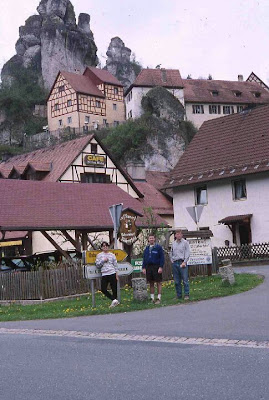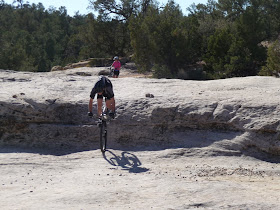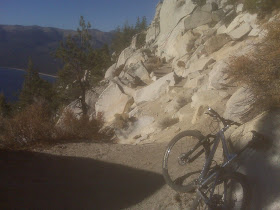 The Challenge
The Challenge
100% house to house self-propelled:
Climb 4 routes in 8 different canyons
“Run” 4,000’ up to 8,000’ and then back home
Ride at least 48 miles with 4,800’ of elevation gain
Carry all of my gear for 32 of those miles (until Lisa shows up)
Climb 32 routes (Lisa’s age in Feb)
At least 4 5.11s and 8 5.10s
Run/hike 4,000’ of elevation gain and 8,000 of elevation change in 8 miles
On-sight at least 4/8ths of the routes
Eat 4 pieces of birthday cake (Romney’s idea)
Drink 8 cocktails (Edwards’ idea)
Do the challenge supports only by the immediate family
Get to the restaurant by 8:48
Theme was an issue. All of my recent challenges have had a theme, and this one was beginning to seem contrived. Okay, so maybe the entire idea of a birthday challenge is contrived in the first place, but I digress.
The old alpine theme didn’t seem appropriate given our long stretch of nearly perfect November weather and nothing else was coming to mind. In fact, I wasn’t even sure I’d be doing a challenge until a few days before it actually happened. So, in the end, I settled on what’s been the theme for my entire year:
Romney and Edwards (and our family).
Training for one of my challenges I ran in Jason and Tiffany Campbell, who had been married that year. When I asked if they were doing a challenge Tiffany replied, “We’re doing the marriage challenge.” Given pretty much no one I know ever thought I’d be attempting that one, it would seem to be enough to suffice for 08. And while our marriage isn’t particularly challenging, life transformations have kept us pretty busy. For this reason I’ve
planned a big year ahead and written it down. It was going to be my entire challenge but, as my birthday approached, I found myself with a bit of fitness, no injuries, and unusually nice weather. It seemed like a cop out not to find a way to suffer for a day. The theme became the same as ours is together: style over statistics.

We care little for the contrivances of the normal world. We didn’t get married to impress anybody, shock anybody, for tax purposes or certainly not to legally start a family. We did it only because we felt like it. It seemed like a good idea to explore life together. And as long as we can do it in good style, we’ll continue. And if we can’t, we’re both in agreement that we won’t let ego keep us together. We’ll be good together, or apart.
Now I just needed a stylish challenge. I really liked
Trent’s self supported canyon challenge. With a little research I found that there were at least 4 routes in 8 canyons that I could ride to. Furthermore, there was an 8,000’ plus peak protruding around 4,000’ above our house. Knowing that with enough time I could finish, which contradicted the birthday challenge ideal that if you know you can do it than it’s not a challenge, Lisa added a speed element: I needed to get to our restaurant of choice by 8:48 (in hindsight, I should have started at 4am.) Kind of like our relationship, it was serendipitously falling into place. That didn’t mean it was all going to be easy.
Corner Canyon: Red Rock

Leaving just after 5am (4 would have sounded better and I’m remiss it wasn’t thought through) I left the house with all the stuff I’d need for the day and rode south. It was 28 degrees and still—as perfect as I could expect for Nov 22. The ride was chilly, uneventful, but a tad hillier than I’d remembered and I was 15 minutes behind schedule when I got to Red Rock.
I chose the 4 best looking routes: a 5.8 and three 5.10s, and did them self belaying on TR. The rock, supposedly quartzite, felt exactly like my old haunt Red Rock near Santa Barbara. I did this alone to let Lisa sleep as the ride to the next area was going to take a while. It seemed quite un-stylish drag her out here to belay me in the dark on four easy routes, and then make here wait while I rode up Little Cottonwood. Self belaying did prove to be slightly slower, and I was further behind schedule upon leaving.
 Little Cottonwood Canyon: Lisa Falls
Little Cottonwood Canyon: Lisa Falls

I’d actually chosen Lisa Falls prior to coming up with a challenge theme because it was high in the canyon and I thought I wanted more elevation gain. Turns out I didn’t need it, nor the miles (I’d be 10-15 over), but it themed out well in the end. It also provided a climbing challenge.
From the topo it looked like I could get four routes from one belay station. As slabby granite goes, it can be confusing to sort out if you’ve never been to the cliff. I few minutes after beginning I was hanging from a bolt looking around and trying to figure out where the routes actually went. I un-stylishly made it to the anchors (an ascent that wouldn’t count) and then spent some time trying to figure out where the lines were.

I finally figured out the puzzle of roofs, slabs, and corners and tr’d four routes: 5.7, 10d, 10b, 8+. We were now WAY behind schedule. My hope was that I could start making up time as the canyons were now closer together. Actually, I thought my chance was ruined but, to paraphrase a line from last year, “I don’t think we’ll make it. But we will continue on in style.”
Deaf Smith Canyon: Hornet’s Nest

I found this cool little canyon on Mountainproject.com. I’d scoped it out and the routes didn’t look bad, though all were supposed to be 5.11. It was a weird type of quartzite/granite-ish mix that reminded me of some of the routes I’d established in the Southern Sierra. I liked it.
Unfortunately, it gave me trouble right off. Half way up the first route; an arête that was steeper than it looked, I was pumped. I nearly lost it high above the last bolt and had to re-focus in order not to fall. This mindset shift was exactly what I needed, because the next route looked a lot harder.
Lisa suggested I take a rest, rationalizing that if I didn’t and fell, it would end up taking longer and we couldn’t get further behind schedule. This turned out as sage advice. I felt great on my next go. The final two routes were done in about 10 minutes.
Ferguson Canyon: The Cathedral

A quick ride made up some time but another long approach lost it. At this point I was worried about the last 5.11 on the list because it looked like a slab. It turned out not to be and, in fact, much easier than the Deaf Smith climbs. I probably climbed these four routes in about 15 minutes. I ran ahead of Lisa on the trail, figuring she would catch me as I rode up Big.
Big Cottonwood: Dogwood

She didn’t. Beata’s no Tuco when it comes to directions and, somehow (though she’s been in Ferguson at least 10 times) she led Romney astray on the way out. It only cost us 5 minutes or so but it seemed ridiculous. At times B can be a perfect mountain companion but, occasionally, she behaves like a six-year old on a sugar high. At least she’s always cute.
I’d never been on the Dogwood slabs but the first one was anything but a mindless romp. The rock was as polished as glass, longer than it looked from the road (causing me to skip some bolts), and the routes didn’t go quickly.
I got faster, made up some more time, but we then hit another snag. Romney was bonking and I was getting pretty spacey. Support duty is not picnic (Bob’s chronic “I’m tired” from 03 comes to mind). We’d already done a lot of hiking and the pace of everything was much quicker than a day at the crags. Lisa hadn’t eaten and needed fuel. So she headed off to get some bagels for us while I rode off towards Mount Olympus.
Tolcat Canyon: Pete’s Rock

Originally I was going to the Sport Utility Crag but, with no approach, I thought Pete’s might be quicker if I could figure it out. This turned out to be a great decision. I hiked to the top and threw a rope down the longest and steepest section of rock. The four routes I did were, amazingly, excellent. Quartzite often hides the nature of its climbing. Most of Big looks nothing like a climbing area but, in my mind, climbs beautifully. Pete’s is historically significant but I’ve always thought that was out of convenience only. It looks like a giant pile of rubble. But I would say the four climbs I did (two were at least 5.10) would get 2 or 3 stars on the Wasatch scale. Climbing in the sun was fun, quick, and I was thinking there was now a chance that I could make it.
Mill Creek Canyon: The Itchy Stitches Wall

I’d been here once before—on No Star Tuesdays—and hoped to never be back. It was, however, the only current choice when one needed to climb four routes in Mill Creek. Perhaps revived by some calories, I felt good riding up the canyon. Then, luckily, the death scree ascent was frozen into place and went fairly easily. The climbs were sharp and nasty but went without a hitch. Soon I was flying down Mill Creek, amazed that we’d get to the final area before it was dark.
Parley’s Canyon: Iron Maiden Wall

These routes had a lot of stars in the guide but my friend Greg had described them as “slick and horrible.” They looked cool from the ground but the rock undulated, making it very hard to see the bolts in the fading light. By the time I was on route one, a headlamp was leading my way.

These were bad—BAD—routes to do in the dark. They weren’t exactly slabs, so you couldn’t just paste your feet, and finding holds was a ridiculous proposition. You’d have to fish around for a rough spot in a sea of dimpled marble. Getting to the anchors on the first route took a long time and, unfortunately, I’d have to lead two in order to climb four routes.
It was even worse for Lisa. Not only did she have to worry about me plunging out of the darkness, but the freeway was a steady stream of noise (too loud to allow communication), and it was propelling a consistent frigid wind into her face. How bad was it? Besides Beata whining up into the darkness at me (she never does this), Romney added, “This makes the Itchy Stitches place seem like paradise.”
The Final Push…

…For the summit was a sufferfest. Romney n’ Ratso took off to get ready for dinner and Beata and I headed up, away from home, onto the well lit slopes of Grandeur Peak. At night, Salt Lake lights up this mountain like a full moon making for a surreal alpine setting. My legs were cooked and the trail on the west ridge is like a stairmaster on the hardest setting.

Near the lower summit we had a dilemma. We were out of time. I called Romney for a strategy session. In order to make it to the restaurant in time, I could either tag the summit and have her pick me up at the trailhead, or turn around and try and get all the way home. As home is a good two miles or more from the trailhead, I wasn’t sure I could even do the latter anyway. I began headed up when sense got the better of me. Style. Wasn’t’ that the order of the day? To get a ride would be like descending K2 in a helicopter—might as well just go up that way. It would be far better to get back to the house under my own power. Given my approaches, I probably had the numbers I needed anyway. But the main point was to get back home the way I began, using my feet.
The descent hurt more than the climb. But the lower we got the clearer it became that there was a chance to make it. We sped up at the trailhead and ran home. I walked into the restaurant with 2 minutes to spare.
 The restaurant was an epilog
The restaurant was an epilog. After not eating much all day the beers (and some bourbon) and the cake were hungrily absorbed for their nutrients. It did include more themed serendipity. Among our friends was Marti, who’d introduced us, Erica, who house sat Tuco while we were eloping, and Lynn, who (and her husband Ben) were a big part of how I chose to move to Salt Lake. The place was also called East West and, now that I’m thinking about it, our relationship heightened while I was in Asia last year. So I guess it’s a challenge that all just fell into place. And the coolest thing is that
it's only the beginning.

 ruking is great for base aerobic conditioning. it's also quite social as you're never very out of breath. the goal is to keep moving with your heart rate up, but way below your LT. it's easy to train with others of different fitness levels with mountainous terrain. sometimes you're walking...
ruking is great for base aerobic conditioning. it's also quite social as you're never very out of breath. the goal is to keep moving with your heart rate up, but way below your LT. it's easy to train with others of different fitness levels with mountainous terrain. sometimes you're walking... and sometimes you're jogging.
and sometimes you're jogging.














































